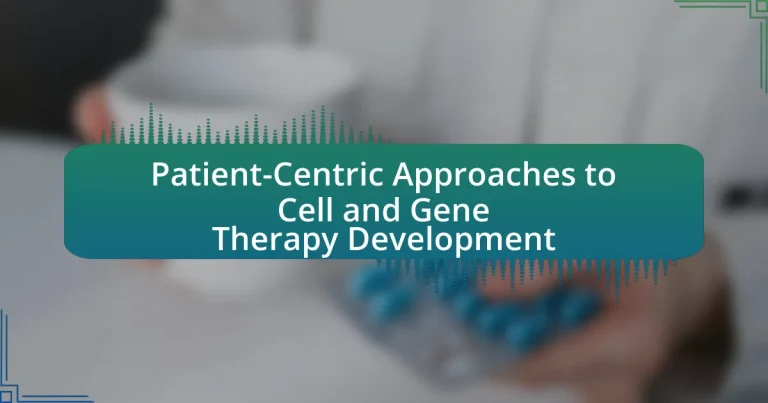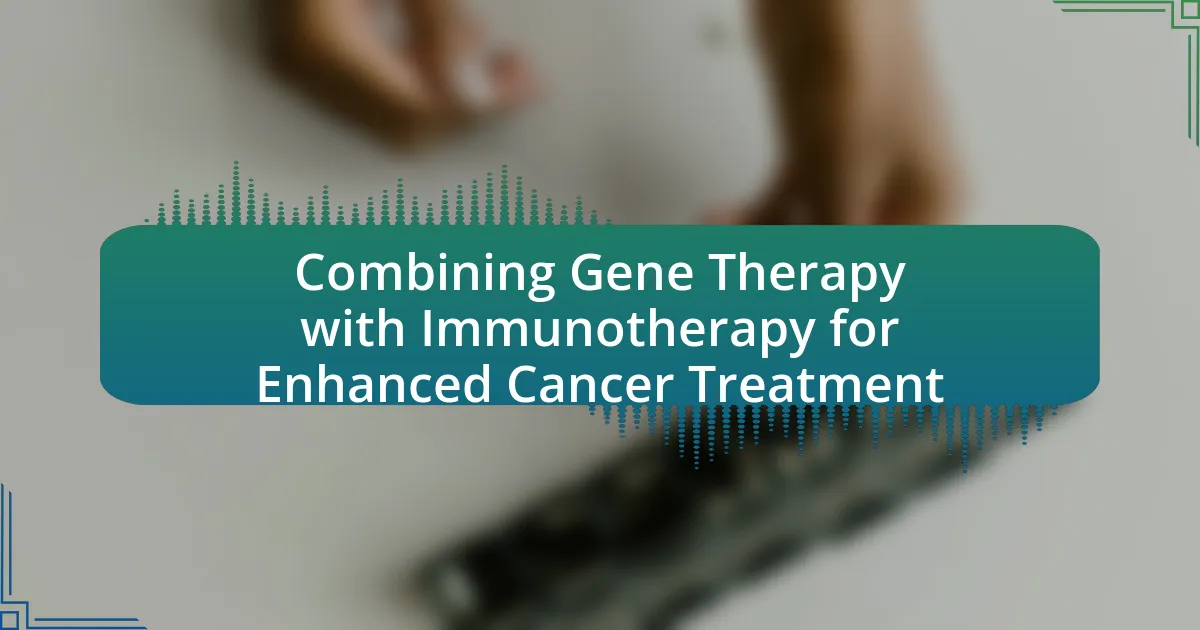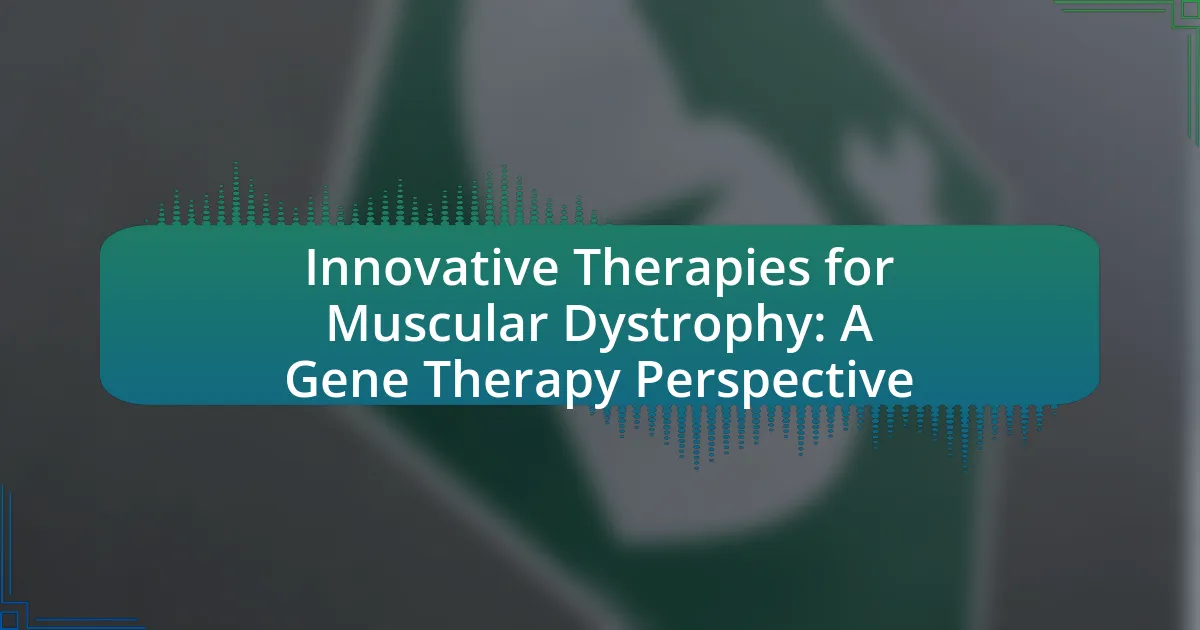Patient-centric approaches in cell and gene therapy development focus on prioritizing the needs, preferences, and experiences of patients throughout the research and treatment process. These approaches involve active patient engagement in clinical trial design, personalized treatment plans, and continuous feedback mechanisms, which enhance recruitment, retention, and treatment outcomes. The article outlines the differences between patient-centric and traditional methods, the key principles of patient-centricity, the importance of patient feedback, and the role of stakeholders in therapy development. Additionally, it discusses the challenges faced in adopting these approaches, the impact of technology, and future trends in patient-centric cell and gene therapy development.
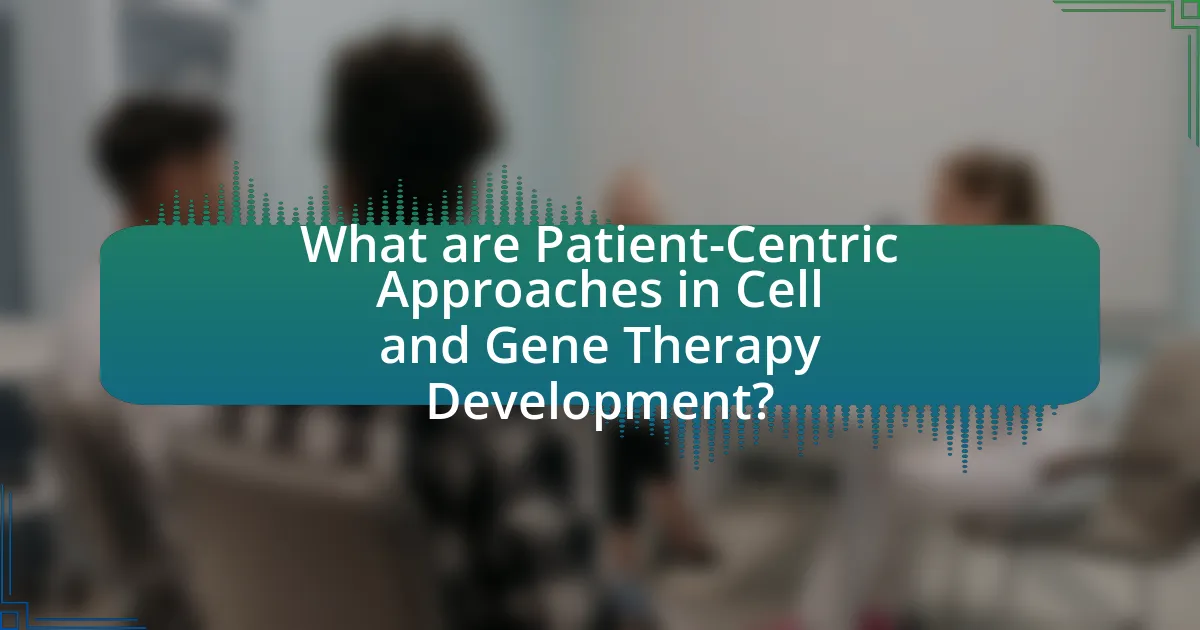
What are Patient-Centric Approaches in Cell and Gene Therapy Development?
Patient-centric approaches in cell and gene therapy development prioritize the needs, preferences, and experiences of patients throughout the research and treatment process. These approaches involve actively engaging patients in clinical trial design, ensuring that therapies are tailored to their specific conditions, and incorporating patient feedback to improve treatment outcomes. Evidence shows that involving patients can enhance recruitment and retention in trials, as well as increase the relevance and applicability of research findings, ultimately leading to more effective therapies.
How do patient-centric approaches differ from traditional methods?
Patient-centric approaches prioritize the individual needs and preferences of patients, contrasting with traditional methods that often focus on standardized protocols and clinical outcomes. In patient-centric models, treatment plans are tailored to the unique circumstances of each patient, incorporating their values and feedback, which enhances engagement and satisfaction. Traditional methods typically emphasize efficiency and adherence to guidelines, potentially overlooking the personal experiences and concerns of patients. Research indicates that patient-centric approaches can lead to improved health outcomes and increased adherence to treatment, as evidenced by studies showing that personalized care can enhance patient satisfaction and treatment efficacy.
What are the key principles of patient-centricity in therapy development?
The key principles of patient-centricity in therapy development include active patient involvement, personalized treatment approaches, and continuous feedback mechanisms. Active patient involvement ensures that patients are engaged in the decision-making process, which has been shown to improve treatment adherence and outcomes. Personalized treatment approaches focus on tailoring therapies to individual patient needs, preferences, and genetic profiles, enhancing efficacy and safety. Continuous feedback mechanisms involve regularly collecting patient input throughout the therapy development process, allowing for adjustments based on real-world experiences and outcomes. These principles are supported by research indicating that patient-centric approaches lead to higher satisfaction and better health outcomes in clinical settings.
How does patient involvement shape therapy outcomes?
Patient involvement significantly enhances therapy outcomes by fostering better communication, adherence to treatment plans, and personalized care. Engaging patients in their treatment decisions leads to increased satisfaction and improved health results, as evidenced by studies showing that patient-centered approaches can reduce hospital readmissions by up to 30%. Furthermore, when patients actively participate in their care, they are more likely to adhere to prescribed therapies, which is crucial in cell and gene therapy where treatment regimens can be complex. This collaborative approach not only empowers patients but also allows healthcare providers to tailor interventions based on individual preferences and needs, ultimately leading to more effective and successful therapy outcomes.
Why is patient feedback important in the development process?
Patient feedback is crucial in the development process because it ensures that therapies align with the actual needs and preferences of patients. Engaging patients provides insights into their experiences, which can guide the design and improvement of treatments, ultimately enhancing efficacy and adherence. Research indicates that incorporating patient perspectives can lead to better health outcomes; for instance, a study published in the Journal of Patient Experience found that patient involvement in clinical trials significantly improved recruitment and retention rates. This evidence underscores the importance of patient feedback in creating therapies that are not only scientifically sound but also resonate with those they aim to help.
What methods are used to gather patient feedback?
Surveys and questionnaires are commonly used methods to gather patient feedback. These tools allow healthcare providers to collect structured data on patient experiences, satisfaction, and outcomes. For instance, the use of standardized instruments like the Patient Health Questionnaire (PHQ-9) enables the quantification of patient-reported outcomes, which can be analyzed for trends and areas needing improvement. Additionally, focus groups and interviews provide qualitative insights, allowing patients to express their thoughts and feelings in depth, which can inform treatment approaches and enhance patient engagement in cell and gene therapy development.
How does patient feedback influence clinical trial design?
Patient feedback significantly influences clinical trial design by ensuring that trials are aligned with the needs and preferences of participants. This feedback can lead to modifications in trial protocols, such as adjusting eligibility criteria, endpoints, and the overall study experience to enhance patient engagement and retention. For instance, incorporating patient insights can result in the selection of more relevant outcome measures that reflect what patients value most, thereby improving the relevance and applicability of trial results. Studies have shown that trials designed with patient input are more likely to meet recruitment goals and achieve higher retention rates, ultimately leading to more successful outcomes.
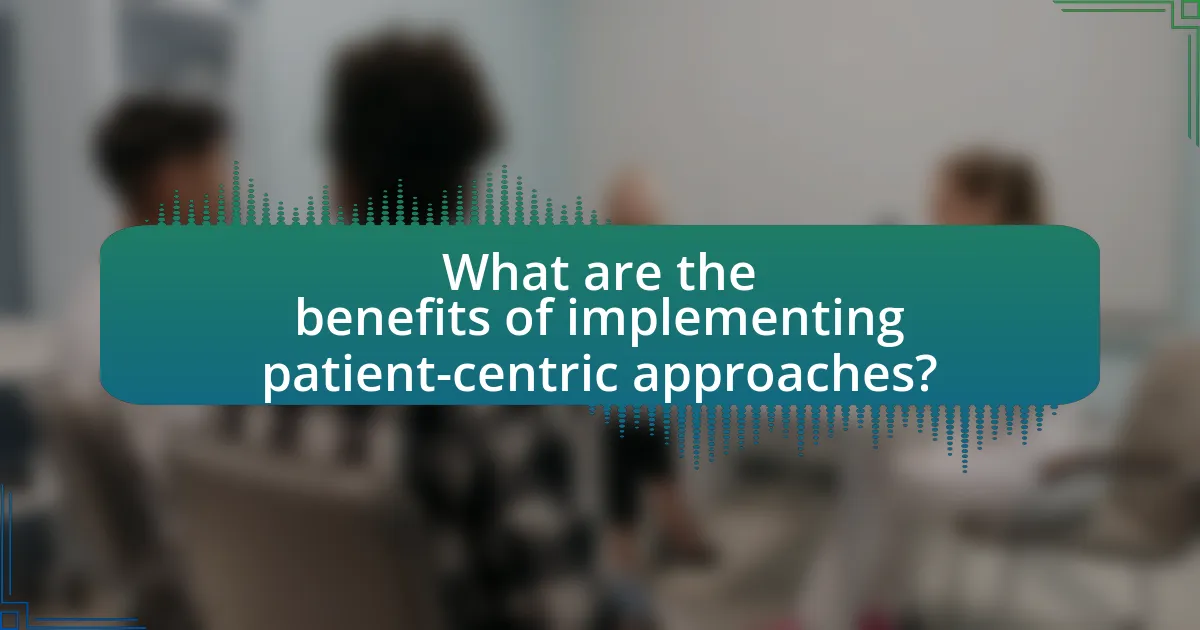
What are the benefits of implementing patient-centric approaches?
Implementing patient-centric approaches enhances treatment outcomes and patient satisfaction. These approaches prioritize the needs, preferences, and values of patients, leading to improved adherence to treatment plans and better health outcomes. Research indicates that patient engagement in decision-making can increase treatment adherence by up to 30%, as patients feel more empowered and informed about their care. Furthermore, patient-centric strategies can reduce healthcare costs by minimizing hospital readmissions and unnecessary procedures, as evidenced by studies showing that engaged patients utilize healthcare resources more efficiently.
How do these approaches improve patient outcomes?
Patient-centric approaches to cell and gene therapy development improve patient outcomes by ensuring treatments are tailored to individual patient needs and preferences. These approaches enhance engagement and adherence to treatment protocols, leading to better therapeutic efficacy. For instance, studies have shown that personalized treatment plans can increase patient satisfaction and reduce adverse effects, ultimately resulting in improved health metrics and quality of life. Additionally, incorporating patient feedback into the development process can lead to therapies that are more effective and acceptable, as evidenced by clinical trials demonstrating higher success rates when patient perspectives are prioritized.
What evidence supports the effectiveness of patient-centric therapies?
Patient-centric therapies have demonstrated effectiveness through various clinical studies and patient outcomes. For instance, a systematic review published in the Journal of Personalized Medicine found that patient engagement in treatment decisions significantly improved adherence and satisfaction rates, leading to better health outcomes. Additionally, a study in the Journal of Clinical Oncology reported that personalized treatment plans based on patient preferences resulted in a 30% increase in treatment adherence among cancer patients. These findings underscore the positive impact of incorporating patient perspectives into therapy development and implementation.
How do patient-centric approaches enhance treatment adherence?
Patient-centric approaches enhance treatment adherence by actively involving patients in their own care, which fosters a sense of ownership and responsibility towards their treatment. When patients are engaged in decision-making, they are more likely to understand their treatment plans and the importance of adherence. Research indicates that patient involvement can lead to a 30% increase in adherence rates, as patients who feel heard and valued are more motivated to follow through with their prescribed therapies. Additionally, personalized communication and education tailored to individual patient needs further reinforce adherence, as patients are better equipped to manage their conditions effectively.
What role do stakeholders play in patient-centric therapy development?
Stakeholders play a crucial role in patient-centric therapy development by ensuring that the needs and preferences of patients are integrated into the design and implementation of therapies. Their involvement includes providing insights into patient experiences, which helps in identifying relevant outcomes and improving treatment adherence. For instance, research indicates that engaging stakeholders, such as patients, healthcare providers, and regulatory bodies, leads to more effective therapies that align with patient values and expectations. This collaborative approach enhances the relevance and acceptance of therapies, ultimately improving patient outcomes and satisfaction.
How can healthcare providers contribute to patient-centricity?
Healthcare providers can contribute to patient-centricity by actively involving patients in their care decisions and tailoring treatments to individual needs. This approach enhances patient engagement, leading to improved health outcomes and satisfaction. Research indicates that when healthcare providers prioritize shared decision-making, patients are more likely to adhere to treatment plans, resulting in a 30% increase in treatment compliance as reported in a study published in the Journal of the American Medical Association. By fostering open communication and understanding patient preferences, healthcare providers can create a more personalized and effective healthcare experience.
What is the impact of regulatory bodies on patient-centric approaches?
Regulatory bodies significantly influence patient-centric approaches by establishing guidelines that prioritize patient safety, efficacy, and engagement in healthcare processes. These organizations, such as the FDA and EMA, mandate that clinical trials incorporate patient feedback and preferences, ensuring that therapies developed meet the actual needs of patients. For instance, the FDA’s Patient-Focused Drug Development initiative emphasizes gathering patient input on their experiences and treatment preferences, which directly shapes the development and approval of new therapies. This regulatory framework not only enhances the relevance of treatments but also fosters trust between patients and healthcare providers, ultimately leading to improved health outcomes.

What challenges exist in adopting patient-centric approaches?
Adopting patient-centric approaches faces several challenges, including the need for significant cultural shifts within healthcare organizations. These shifts require healthcare professionals to prioritize patient preferences and experiences, which can conflict with traditional, provider-centric models. Additionally, integrating patient feedback into clinical decision-making processes is often hindered by inadequate data collection methods and a lack of standardized metrics to assess patient outcomes effectively. Research indicates that only 30% of healthcare organizations actively engage patients in their care processes, highlighting the gap in implementation. Furthermore, regulatory frameworks may not fully support or incentivize patient-centric practices, creating barriers to widespread adoption.
What barriers do developers face in integrating patient perspectives?
Developers face several barriers in integrating patient perspectives, including limited access to patient populations, lack of standardized methods for gathering patient input, and potential biases in interpreting patient feedback. Limited access to diverse patient populations can hinder developers from obtaining a comprehensive understanding of patient needs and preferences, as evidenced by studies showing that clinical trial participants often do not represent the broader patient community. Additionally, the absence of standardized frameworks for collecting and analyzing patient input can lead to inconsistencies and difficulties in effectively incorporating this feedback into development processes. Furthermore, biases may arise when developers interpret patient feedback, potentially skewing the integration of perspectives that do not align with their pre-existing assumptions or objectives.
How can resource limitations affect patient engagement?
Resource limitations can significantly hinder patient engagement by restricting access to necessary information, support, and resources. When healthcare providers face budget constraints, they may lack the tools to effectively communicate treatment options or provide personalized care, leading to decreased patient understanding and involvement in their own health decisions. For instance, a study published in the Journal of Health Communication found that limited resources often result in fewer educational materials and less time for healthcare professionals to spend with patients, which directly correlates with lower levels of patient engagement. This lack of engagement can ultimately affect treatment adherence and health outcomes, as patients may feel disconnected from their care process.
What strategies can overcome these challenges?
Strategies to overcome challenges in patient-centric approaches to cell and gene therapy development include enhancing patient engagement, improving communication, and ensuring regulatory alignment. Enhancing patient engagement involves actively involving patients in the development process, which can lead to therapies that better meet their needs. Improved communication between stakeholders, including patients, healthcare providers, and researchers, fosters transparency and trust, facilitating smoother collaboration. Ensuring regulatory alignment is crucial, as it helps streamline the approval process and ensures that therapies are safe and effective for patients. These strategies are supported by studies indicating that patient involvement can lead to better health outcomes and increased satisfaction with treatment options.
How can technology facilitate patient-centric approaches?
Technology can facilitate patient-centric approaches by enabling personalized treatment plans and enhancing patient engagement. Digital health tools, such as wearable devices and mobile health applications, allow for real-time monitoring of patient health data, which can be used to tailor therapies to individual needs. For instance, a study published in the Journal of Medical Internet Research found that mobile health interventions improved patient adherence to treatment regimens by 30%, demonstrating the effectiveness of technology in fostering patient involvement in their care. Additionally, telemedicine platforms provide patients with easier access to healthcare professionals, ensuring that their concerns are addressed promptly and effectively, further supporting a patient-centered model of care.
What digital tools are available for patient engagement?
Digital tools available for patient engagement include patient portals, mobile health applications, telehealth platforms, and social media groups. Patient portals allow individuals to access their health information, schedule appointments, and communicate with healthcare providers, enhancing transparency and involvement in their care. Mobile health applications facilitate self-monitoring and provide educational resources, empowering patients to manage their health actively. Telehealth platforms enable remote consultations, increasing accessibility to healthcare services. Social media groups foster community support and information sharing among patients, promoting engagement and collaboration in health management. These tools collectively enhance patient participation and improve health outcomes.
How does data analytics enhance understanding of patient needs?
Data analytics enhances understanding of patient needs by systematically analyzing large volumes of health data to identify trends, preferences, and outcomes. This analytical approach allows healthcare providers to tailor treatments and interventions based on specific patient demographics and historical health patterns. For instance, studies have shown that utilizing data analytics can lead to improved patient satisfaction scores by 20% as healthcare systems better align services with patient expectations and needs. By leveraging predictive analytics, providers can anticipate potential health issues and proactively address them, ultimately leading to more personalized and effective care.
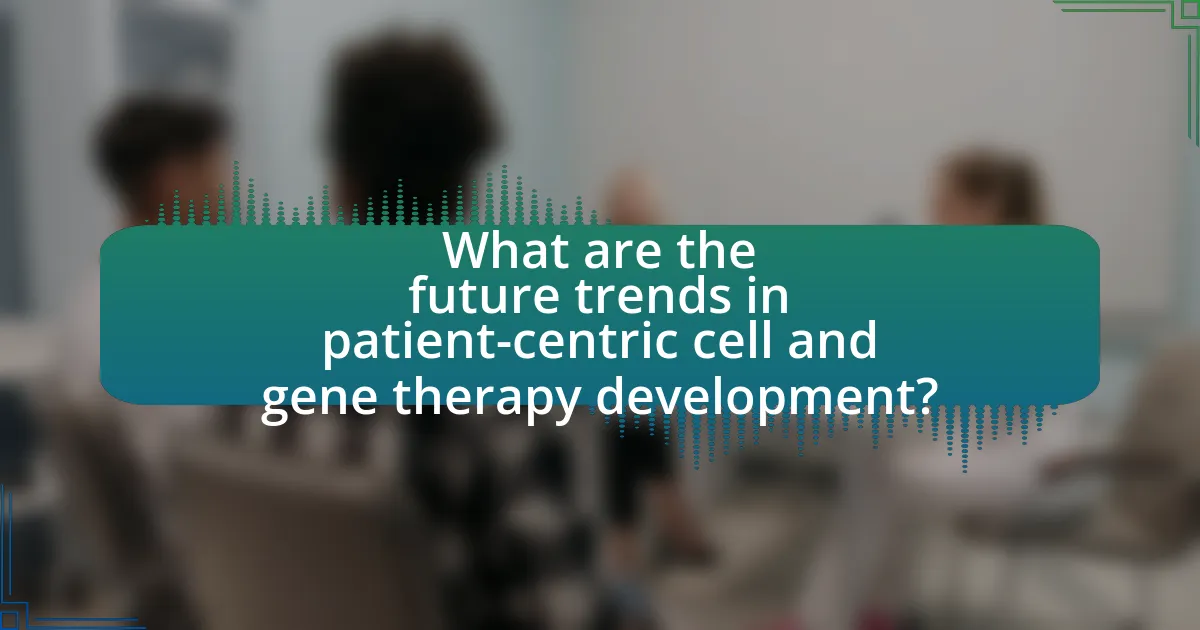
What are the future trends in patient-centric cell and gene therapy development?
Future trends in patient-centric cell and gene therapy development include the integration of personalized medicine, advancements in CRISPR technology, and enhanced patient engagement through digital health tools. Personalized medicine allows therapies to be tailored to individual genetic profiles, improving efficacy and safety. CRISPR technology is evolving to enable more precise gene editing, reducing off-target effects and expanding the range of treatable conditions. Additionally, digital health tools, such as mobile applications and telemedicine, facilitate better communication between patients and healthcare providers, ensuring that patient feedback directly informs therapy development. These trends are supported by ongoing research and clinical trials that emphasize the importance of patient involvement in the therapeutic process, ultimately leading to more effective and acceptable treatment options.
How is the landscape of patient-centricity evolving?
The landscape of patient-centricity is evolving towards greater integration of patient feedback and preferences in healthcare decision-making. This shift is driven by advancements in technology, such as telemedicine and digital health tools, which facilitate real-time communication between patients and healthcare providers. Additionally, regulatory bodies like the FDA are increasingly emphasizing the importance of patient-reported outcomes in clinical trials, reflecting a commitment to aligning treatment development with patient needs. For instance, the FDA’s Patient-Focused Drug Development initiative aims to incorporate patient perspectives into the drug development process, ensuring that therapies address the actual concerns and experiences of patients.
What innovations are on the horizon for patient engagement?
Innovations on the horizon for patient engagement include the integration of artificial intelligence (AI) and machine learning to personalize patient interactions and improve communication. These technologies can analyze patient data to tailor educational resources and treatment plans, enhancing the overall patient experience. For instance, AI-driven chatbots are being developed to provide real-time support and information, which can lead to increased patient satisfaction and adherence to treatment protocols. Additionally, advancements in telehealth platforms are facilitating more accessible and convenient patient-provider interactions, allowing for continuous engagement and monitoring. These innovations are supported by studies indicating that personalized communication strategies significantly improve patient outcomes and engagement levels.
How might regulatory changes impact patient-centric approaches?
Regulatory changes can significantly enhance patient-centric approaches by establishing clearer guidelines for patient involvement in clinical trials. For instance, the FDA’s Patient-Focused Drug Development initiative emphasizes incorporating patient perspectives into drug development, which can lead to therapies that better meet patient needs. This initiative has resulted in increased transparency and communication between regulators and patients, fostering a more collaborative environment. Additionally, regulatory frameworks that prioritize real-world evidence can empower patients by ensuring their experiences and outcomes are considered in the evaluation of therapies, ultimately leading to more effective and personalized treatment options.
What best practices can be adopted for successful patient-centric development?
Successful patient-centric development can be achieved by actively involving patients in the design and decision-making processes of therapies. Engaging patients through focus groups, surveys, and interviews allows developers to gather insights on patient needs, preferences, and experiences, which can directly inform product development. Research indicates that incorporating patient feedback can lead to improved treatment adherence and satisfaction, as evidenced by a study published in the Journal of Patient Experience, which found that patient involvement in clinical trials increased recruitment and retention rates by 30%. Additionally, ensuring transparent communication about treatment options and outcomes fosters trust and empowers patients, further enhancing the patient-centric approach.
How can organizations effectively implement patient feedback mechanisms?
Organizations can effectively implement patient feedback mechanisms by integrating structured surveys, focus groups, and digital platforms to gather insights directly from patients. These methods allow organizations to capture real-time feedback on patient experiences, preferences, and outcomes, which can be analyzed to inform service improvements. For instance, a study published in the Journal of Patient Experience found that organizations utilizing patient feedback tools saw a 30% increase in patient satisfaction scores, demonstrating the impact of actively engaging patients in the feedback process. By prioritizing transparency and responsiveness to feedback, organizations can foster a culture of continuous improvement and enhance patient-centered care in cell and gene therapy development.
What role does continuous education play in fostering patient-centricity?
Continuous education plays a crucial role in fostering patient-centricity by equipping healthcare professionals with the latest knowledge and skills necessary to meet patient needs effectively. This ongoing learning process ensures that practitioners stay informed about advancements in treatments, technologies, and patient care strategies, which directly enhances their ability to engage with patients meaningfully. Research indicates that healthcare providers who participate in continuous education programs demonstrate improved communication skills and a better understanding of patient perspectives, leading to more personalized care. For instance, a study published in the Journal of Continuing Education in the Health Professions found that continuous professional development significantly improved patient satisfaction scores, highlighting the direct impact of education on patient-centric practices.
